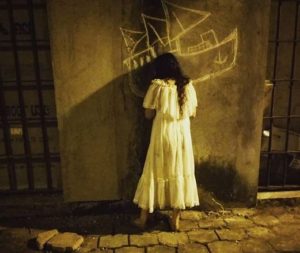Podcast: Play in new window | Download
Subscribe: Apple Podcasts | RSS
The state of Veracruz is located on Mexico’s Gulf Coast. Its territory encompasses sandy beaches, dense jungles and high alpine forests. The Spanish established a presence there in the early 1500s. There are many myths and legends found in Veracruz. Here are four.
1. Diamond Alley
 In Veracruz’ capital city of Xalapa there exists an alley by the name of Primera de Antonio Maria de Rivera which carries the nickname today, “Diamond Alley.” The surrounding area is full of nice restaurants, cosmopolitan cafes, eclectic art galleries and busy shops. In colonial times a young married couple lived in a stately home off the alley. The young man was a rich Spanish gentleman and belonged to a minor noble family in Spain. The young woman was born in New Spain and known throughout the area for her incredible beauty and impeccable reputation. Before the two were married, the young man courted his future wife extensively and when the time was right, he asked for her hand in marriage. When he proposed the man gave his lovely future wife a beautiful ring. The ring’s center contained a beautiful black diamond. Those who heard of the jewel said it was magical. The young man joked that the diamond ring not only had the power to intensify love it also had the power to uncover infidelity.
In Veracruz’ capital city of Xalapa there exists an alley by the name of Primera de Antonio Maria de Rivera which carries the nickname today, “Diamond Alley.” The surrounding area is full of nice restaurants, cosmopolitan cafes, eclectic art galleries and busy shops. In colonial times a young married couple lived in a stately home off the alley. The young man was a rich Spanish gentleman and belonged to a minor noble family in Spain. The young woman was born in New Spain and known throughout the area for her incredible beauty and impeccable reputation. Before the two were married, the young man courted his future wife extensively and when the time was right, he asked for her hand in marriage. When he proposed the man gave his lovely future wife a beautiful ring. The ring’s center contained a beautiful black diamond. Those who heard of the jewel said it was magical. The young man joked that the diamond ring not only had the power to intensify love it also had the power to uncover infidelity.
The young Spanish gentleman had a business partner whom he loved like a brother. As fate would have it, this business partner had eyes for this man’s new wife. The beautiful young woman, once known for her flawless virtue, started to see this other man behind her husband’s back. When the young husband took a business trip to Mexico City, his wife used his prolonged absence as an opportunity to spend all of her free time with her new paramour. One day, she forgot the black diamond ring at his house. On that day, her husband returned from Mexico City, but instead of going directly home, he stopped off at the house of his business associate. The business associate was asleep when the Spanish gentleman entered his home, and when he entered the bedroom he saw his wife’s black diamond ring on his friend’s nightstand. Without making a sound, he took the ring and returned home.
Upon arrival, he went to their bedroom when here found his wife, who greeted him with a hug. The sadness that the man felt became anger, and mad with jealously, he drew out a dagger and struck his wife in the chest, killing her instantly. He picked her up, carried her to the bed, threw the ring there, left his house and no one ever saw him again in Xalapa.
Soon after the murder the neighbors noticed something very curious: On some nights they claimed they saw the silhouette of a woman hurrying down the alley. Others claim to hear the voice of a woman in this alley, crying out for her husband to forgive her, and when anyone goes out to assist, the voice just stops.
2. The Enchanted Cave
June 24th is the saint’s day for San Juan and in many towns in the state of Veracruz it is considered “The Day of Enchantment.” Throughout the state there are many caves that are decorated with flowers, but subtly guarded to prevent people from entering them on that day. The legend of the Enchanted Cave cannot be pinpointed to a certain place, as its exact location has been lost over the centuries.
As legend has it, Jacinto was the best blacksmith in his town. As a child, he was attracted to a local cave but the boulder that covered the entrance was very heavy and he only managed to look inward through a small crack between the boulder and the lip of the cave. On one June 24th Jacinto decided to visit his favorite cave and found it completely open, with the boulder moved to the side. Excited, he wanted to satisfy his curiosity and so he entered the cave. Deep inside it he arrived at a chamber full of lit candles. In the center of this room lit by thousands of candles there  were several tables covered with fine linens and glassware that seemed very fine. On each of the tables there was also splendid food, better than what Jacinto had seen in the houses of rich people in his town. The boy explored the candlelit cavern and discovered several wooden trunks lined up against a wall. The trunks had their lids open, exposing an infinite amount of gold coins, jewelry and precious stones. Jacinto gazed at the treasure and wondered if it had come from pirates who had sacked the city of Veracruz many years before. The boy was snapped out of his reverie when a well-dressed woman grabbed his arm. She led him to one of the tables around which other elegant ladies sat. Soon, servants appeared and poured wine and dished out plates of delicacies. The young Jacinto was enjoying his food when a tall, dark man dressed in fine clothes approached him. The man scared him, and he tried to leave. However, the mysterious man grabbed the boy and did not let him go, asking to finish everything on his plate first. He also made him promise that he would return in three days. Finally, the tall man let the boy go.
were several tables covered with fine linens and glassware that seemed very fine. On each of the tables there was also splendid food, better than what Jacinto had seen in the houses of rich people in his town. The boy explored the candlelit cavern and discovered several wooden trunks lined up against a wall. The trunks had their lids open, exposing an infinite amount of gold coins, jewelry and precious stones. Jacinto gazed at the treasure and wondered if it had come from pirates who had sacked the city of Veracruz many years before. The boy was snapped out of his reverie when a well-dressed woman grabbed his arm. She led him to one of the tables around which other elegant ladies sat. Soon, servants appeared and poured wine and dished out plates of delicacies. The young Jacinto was enjoying his food when a tall, dark man dressed in fine clothes approached him. The man scared him, and he tried to leave. However, the mysterious man grabbed the boy and did not let him go, asking to finish everything on his plate first. He also made him promise that he would return in three days. Finally, the tall man let the boy go.
Jacinto ran as fast as he could and when he arrived at his village the townsfolk could not believe it was him. Several months had passed since they last saw him, and his family and friends took him for dead. Jacinto realized that what he believed was just a couple of hours was, in fact, a whole year. He regaled the whole town with stories of the cave, including details about the treasure, the scary tall man and the elegant ladies.
Jacinto disappeared after the third day of his return. His neighbors found him dead, trapped between the cave and the large boulder at its entrance. It is said that since then, no one has been able to move that huge rock. Some people think the cave is a portal to another dimension or another world. So, visitors to any cave are warned not to enter or they may meet the same fate as Jacinto.
3. The Woeful Tale of the Countess of Malibrán
In the older walled part of the city of Veracruz sometime in the early 1600s there were many rumors about the strange goings-on in the house of a foreign woman who was very beautiful, approaching middle age and very haughty. She was the wife of a Spanish nobleman, the Count of Malibrán, a successful businessman in colonial New Spain whose various enterprises caused him to travel a great deal. The count was away from home more than he was there, and when he was away, the countess would engage in questionable practices. According to her neighbors, she would regularly visit an older indigenous woman who lived in a village outside the city. The countess made these visits to this old sorcerer woman because she was desperate to have children. As part of the remedy, the old indigenous healer gave her advice which caused the countess to engage in another questionable practice: hosting lavish parties in her home while her husband was away. A key component of these parties were the young sailors that the countess would hand pick by walking the docks. These handsome young men hailed from all over the world, and with the proper enticement, the aging countess would have whatever man she wanted. Many of the ships that called into the port of Veracruz would depart leaving one or two sailors behind, as those invited to the parties at the Malibrán mansion would never report back for duty on their vessels.
 One day the Count of Malibrán came home early from one of his business trips without telling anyone. He found his house overrun by partiers and encountered his wife in their bedroom with two young sailors. Enraged, the count attacked the two young men and killed them with his sword. One of the mansion’s slaves helped the count get rid of the bodies as was normal for him to do at the end of one of the countess’ parties. They took the bodies to a pit in the back of the property where all the other victims lay. The count, upon seeing the pit, went mad and lost his sanity.
One day the Count of Malibrán came home early from one of his business trips without telling anyone. He found his house overrun by partiers and encountered his wife in their bedroom with two young sailors. Enraged, the count attacked the two young men and killed them with his sword. One of the mansion’s slaves helped the count get rid of the bodies as was normal for him to do at the end of one of the countess’ parties. They took the bodies to a pit in the back of the property where all the other victims lay. The count, upon seeing the pit, went mad and lost his sanity.
To this day, the Malibrán mansion exists, but in ruins. Locals who dare venture near the property say they can hear faint laments and moans, and even someone occasionally yelling “Let the countess die!” Sometimes the dark figure of a woman is reported, wearing 17th Century clothing, and laughing at passersby, especially at the handsome young men.
4. The Mulata of Córdoba
This story allegedly comes out of the archives of the Holy Inquisition in Mexico City. It dates from the late 16th Century, either the 1580s or 1590s. The documents tell the tale of a very beautiful woman who was the daughter of an African slave and a common Spanish settler. The woman’s name was Soledad and she lived in the town of Córdoba located away from the coast and near the volcano Pico de Orizaba, the highest mountain in Mexico. Soledad never grew old and people in the town suspected it was because she was practicing African magic thar she had learned from her mother. She was also a great herbalist and many people would make long journeys to seek out her help. Soledad could cure many diseases and was well respected. Unfortunately, her keen abilities, great knowledge and stunning beauty often invoked envy. Soledad rejected potential suitors because she was dedicated to the work of healing the sick and felt she had no time to carry out the domestic duties of a housewife. One of her rejected suitors was Don Martín de Ocaña, the mayor of the town, who, disgusted, began to spread rumors that Soledad was a witch. Not only that, the mayor claimed that she had given him a special potion to make him fall in love with her. Soon, word spread throughout the area of Soledad’s possible connection to witchcraft and her story eventually reached the offices of the Holy Inquisition in Mexico City.
When the Holy Office sent inquisitors to the town, many townspeople felt scared and wanted to cooperate with the Catholic Church. When they were interrogated by the ecclesiastical authorities, many said they heard Soledad laugh at midnight and that they saw her fly over the rooftops. The girls in the town said she was always trying to sell them love potions and spells to help them ensnare unsuspecting men. Soledad ignored all the commotion and even continued to attend Mass every Sunday.
 Nevertheless, the Inquisition sent several men to arrest Soledad and they took her to the prison of San Juan de Ulúa on the coast. She was scheduled to be burned at the stake and while she waited for her fateful day Soledad languished in her cell, bored. One day she asked one of her jailers if she could have a small piece of coal so she could entertain herself by drawing on the wall. The day before her execution, Soledad showed the head jailer what she had drawn on the cell’s wall: A beautiful large-masted ship in full sail. While she was explaining her drawing, Soledad unexpectedly jumped into the boat, mixed with the drawing on the wall and the ship began to move away until it disappeared forever. Minutes later, missing their boss, other jailers went down to the dungeon to find him. When they arrived at Soledad’s cell, the prisoner was gone and the head jailer was dead on the floor in front of the door.
Nevertheless, the Inquisition sent several men to arrest Soledad and they took her to the prison of San Juan de Ulúa on the coast. She was scheduled to be burned at the stake and while she waited for her fateful day Soledad languished in her cell, bored. One day she asked one of her jailers if she could have a small piece of coal so she could entertain herself by drawing on the wall. The day before her execution, Soledad showed the head jailer what she had drawn on the cell’s wall: A beautiful large-masted ship in full sail. While she was explaining her drawing, Soledad unexpectedly jumped into the boat, mixed with the drawing on the wall and the ship began to move away until it disappeared forever. Minutes later, missing their boss, other jailers went down to the dungeon to find him. When they arrived at Soledad’s cell, the prisoner was gone and the head jailer was dead on the floor in front of the door.
According to legend, the authorities closed down the port of Veracruz on the day of Soledad’s disappearance due to a great thunderstorm. Eyewitnesses claimed to see, however, beyond the breakwaters, the outlined figure of a great ship, between the rain and the wind of the north, heading for the open sea.
REFERENCES
Matador.com Spanish language website about Mexican legends and other curiosities. https://matadornetwork.com/es/category/lugares/mexico/

2 thoughts on “Four Legends from Veracruz”
Hi,
I’m trying to track down a story I was told as a child. All I remember is it was about a small town in Latin America that faced many challenges. Each night a marimba player would play to soothe the towns troubles away. Are you familiar with this story?
Sorry, I have never heard of that story.